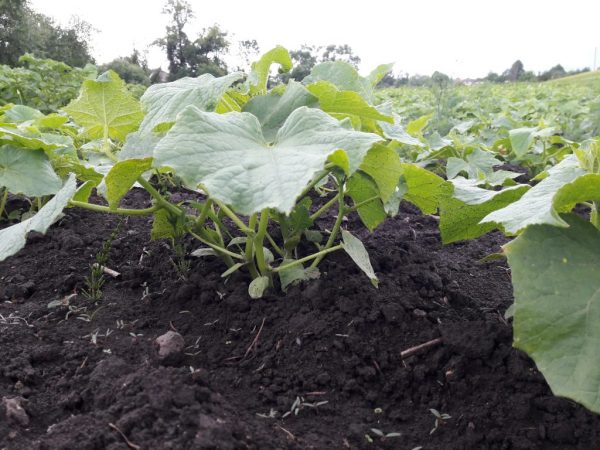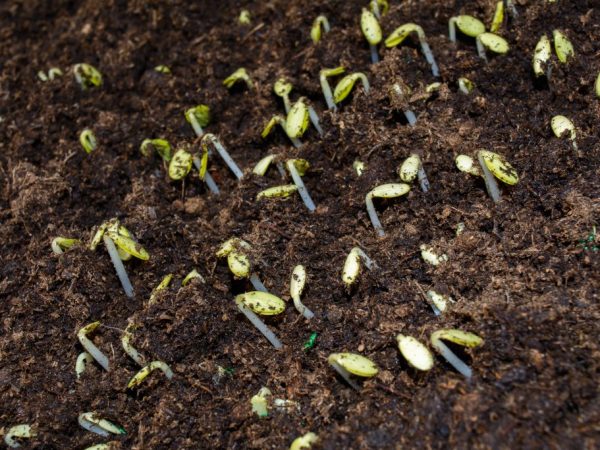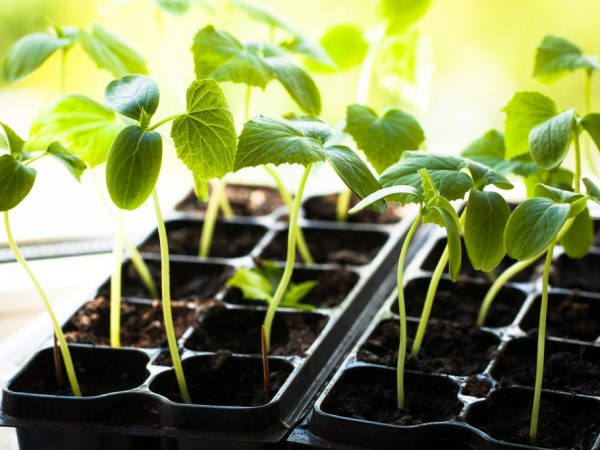Rules for growing cucumbers in the open field
Growing cucumbers in the open field has its own characteristics. Productivity largely depends on weather conditions, therefore, protecting cucumber bushes from the sun, which is harmful to them or from destructive frosts, is often a difficult task. Caring for cucumbers in the open field is complicated by the development of numerous bacterial and infectious diseases that birds and insects carry.

Rules for growing cucumbers in the open field
Sowing area preparation
Seat selection
Before you start sowing cucumber seeds or seedlings in open soil, you need to choose the right place, taking into account the requirements that the vegetable culture makes for cultivation.
The sown area for cucumbers should be located in a sheltered from the winds, in a sufficiently sunny place, the surface of the soil layer is even.
Secondly, before developing the land for planting cucumbers, it is recommended to analyze it for its passage in the layers of groundwater and by the type of acidity, since cucumber varieties do not grow well on over-acidified soil.
The introduction of limestone and dolomite flour helps to bring the acidity level in the soil layers to the desired indicator.
Thirdly, when eliminating the consequences of risky farming, you should choose a place where predecessors that are not suitable for the type of feeding for the cucumber crop have not grown before. Cucumbers grow well between tomato and beet plantings.
Soil preparation
When a place for future planting of cucumber culture is selected, a number of measures are required to prepare the land. You can get a good harvest only on non-alkaline, non-heavy and multi-fertile soils, therefore experienced gardeners begin to prepare a place for sowing in spring in the fall:
- The cultivated area is cleared of old vegetation, as well as garden debris, and experts in the cultivation of cucumbers in the open field try to do this even before the onset of the autumn rains to prevent rot from the remaining weeds in the damp soil.
- After cleaning, the land plot is dug up, while fertilizing the soil with mineral compounds. The depth of digging the soil should be at least 15 cm. Many summer residents cannot do without mulching.
- At the onset of spring, the soil layers loosen and remove the young weeds that have appeared, using a cultivator or a rake. Loosening helps to retain the moisture accumulated in the ground, which is necessary for future plantings. Immediately before planting cucumber seeds and seedlings, the soil is leveled. This is done so that the seeds can easily sprout in the ground without lumps, and the seedlings take root in a short time, actively developing root shoots.
Seed material
The stage of seed preparation is important, because the quality of the seeds determines whether future cucumbers will take root in the open field, how they will resist diseases and pests, and whether they will be able to survive under changing climatic conditions.
Seeds for growing cucumbers in open soil are taken for planting healthy, without external damage and with germination rates within 90%.
Rejection
Seeds of cucumber varieties suitable for planting in open soil are rejected and calibrated. This is easily done by soaking the material in a 3% sodium chloride solution. The principle of this method of rejection is to use seeds that have sunk to the bottom of the container. All the seed material floating on the surface of the liquid is removed as low-quality.
Treatment
Seeds selected as a result of rejection are recommended to be treated with drugs against infectious and bacterial diseases. Gardeners often prefer to use the drug Fentiuram as a suitable tool. It requires 0.4 g for every 5 kg of seed. After processing, the seeds are sent to the oven for about 1 hour for thermal hardening at a temperature of at least 70 ° C.
Landing in open ground

It is necessary to sow seeds in open ground after all frosts.
You can plant cucumbers in an open garden both with seeds and with already grown seedlings. It is important to take into account the peculiarities of the climate: early-ripening varieties are suitable for cold zones, and late-ripening f1 hybrids can be high-yielding in warm regions, both when grown on an industrial scale, and in a limited space of a summer residence.
Seed method
Seeds are sown on a bed not protected from the influence of the environment, when warm weather has finally established and the last morning frosts have passed. The soil layer must warm up to a temperature of at least 15 ° C. The degree of warming up of the earth depends on how much the risk of rotting of the seed material will be.
The planting start period varies depending on the region of cultivation of the vegetable crop. In cool climatic areas, summer residents begin to plant f1 hybrids not earlier than the end of May, in some cases even at the beginning of June. Southern gardeners plant cucumber varieties after half of April.
For every 1 sq. m of sown area usually takes about 50 g of dry cucumber seeds. If the seeds were germinated before planting, their number per square meter is halved.
Distance
The optimal distance between future shoots is from 12 cm to 15 cm. It is observed in order to prevent diseases arising from insufficient ventilation of young shoots. In addition, it will be easier to care for them this way.
Protection
At the initial stage, a seed-planted vegetable crop can be protected from environmental influences by mulching, which is recommended by organic matter (fermented in buckets with manure, peat, humus or compost), as well as covering it with polypropylene fiber.
Seedling method
Planting of grown cucumber seedlings begins only after the end of the morning frost period. Saplings that have collected a sufficient amount of green mass are planted at the same distance as the seeds are sown.
In the conditions of growing cucumbers in regions with cold weather, the seedlings are often lingering in the apartment for a long time, since the ground, which is not heated to the required temperature, does not allow transplanting young plants to the street. Sometimes the first flowers begin to appear at the seedlings at this time. They are removed, because at this stage the plant requires a large amount of strength for the development of the aboveground and underground parts, and the flowering process itself prevents this.
Also, when planting seedlings in open soil, it slows down the process of plant adaptation to new conditions, flowering seedlings take root on the street much worse.
Growing seedlings
For the seedling method of planting cucumbers in open ground, it is required to grow cucumber seedlings.
Gadgets
For the purpose of growing cucumber seedlings, seedling containers are used: containers filled with a loose substrate enriched with nutritious mineral components.
Today, modern mobile seedling devices with a heating function are gaining popularity.
Peat blocks with separate cells are also suitable for growing cucumber seedlings. Initially, they are soaked, and then cucumber seeds are planted in each compartment.

Plastic container for planting requires drainage
Simple plastic cups or other plastic containers are also suitable for planting seeds. An important condition for the use of such a container is the presence of drainage, which is laid from any absorbent material, for example, expanded clay, vermiculite. Some summer residents from the southern regions use the husk from sunflower seeds as an absorbent.
Soil mixture
When growing seedlings of cucumbers for subsequent transplantation into open soil, it is recommended to use land that is similar in characteristics to that in which a vegetable crop will subsequently be grown in the sowing area. This will allow the cucumber seedlings to go through the adaptation process on the street faster.
You can prepare a homemade soil mixture by mixing turf, peat and sand in equal proportions.
Sowing
Sowing seeds prepared for planting is required to a depth of no more than 1-2 cm. The number of cucumber seeds per container is 2 pieces.
Care
Subsequent care for germinating cucumber seeds involves maintaining the required temperature at a level not lower than 18-21 ° C until the moment the first shoots appear. With the first sprouts, containers with cucumber seedlings are transferred to a cooler place (15 ° C), which prevents excessive pulling of young seedlings.
With sudden changes in temperature, seedlings are often affected by a black leg and ascochitosis (black rot). Infected shoots are immediately removed, and the remaining shoots are treated with fungicides as a preventive measure.
Good lighting helps the cucumber seedlings to form a strong root system, which is important for subsequent transplanting into open ground. Watering young seedlings is recommended with warm water. Seedlings are sprayed in the morning.
Planting care
When the first seedlings have sprouted from the seeds, or when the finished seedlings are transplanted into outdoor conditions, caring for cucumber plantings involves controlling moisture, watering, providing food, protecting against pests and diseases, etc.
Humidity and watering
Moisture readings depend on the stage of plant development:
- at the initial stages of the growing season, the humidity is maintained at the level of 60-70%,
- at the fruiting stage - about 80%,
- in the final stage of the growing season - 75-80%.
When growing cucumbers in open soil, the main watering of plants is reduced to rain. However, in the summer season, additional moisture is required. Usually, watering is carried out no more than once every 8-10 days, but in the warm season in dry weather, cucumber plantings need to be watered with a frequency of up to 1 time in 5 days.
Food
Mineral nutrition is added throughout the growing season. The initial feeding falls on the first 2-3 leaves and assumes the saturation of the soil with a nitrogen-containing component. It is made at the rate of 1.5 kg of mineral composition for every 10 sq. m of sown area.
Some people use mullein, bread or herbal infusions to feed cucumber plantings, alternating minerals with organic matter.
Secondary feeding falls on the stage of formation of lateral processes and requires the addition of potassium along with nitrogen.Potash-nitrogen fertilizers are consumed at the rate of 2 kg of mineral complexes for every 8-10 sq. m of sown area.
Pinching and pinching
The formation of cucumber bushes involves 2 main technologies:
- Topping. Formed lashes are launched along the net or trellises, tying them to a support as the bush grows, then pinch the main stem as soon as it reaches the trellis base, removing the first 3 leaves with axils and male barren flowers.
- Stealing. This procedure for removing excess lateral shoots helps to obtain an earlier harvest. However, many summer residents who grow cucumbers in the open field with high fertility rates do not resort to pinching. If you want to experiment with the amount of harvest, you can remove side shoots that do not bear fruit, growing after the first 4-5 leaves.


